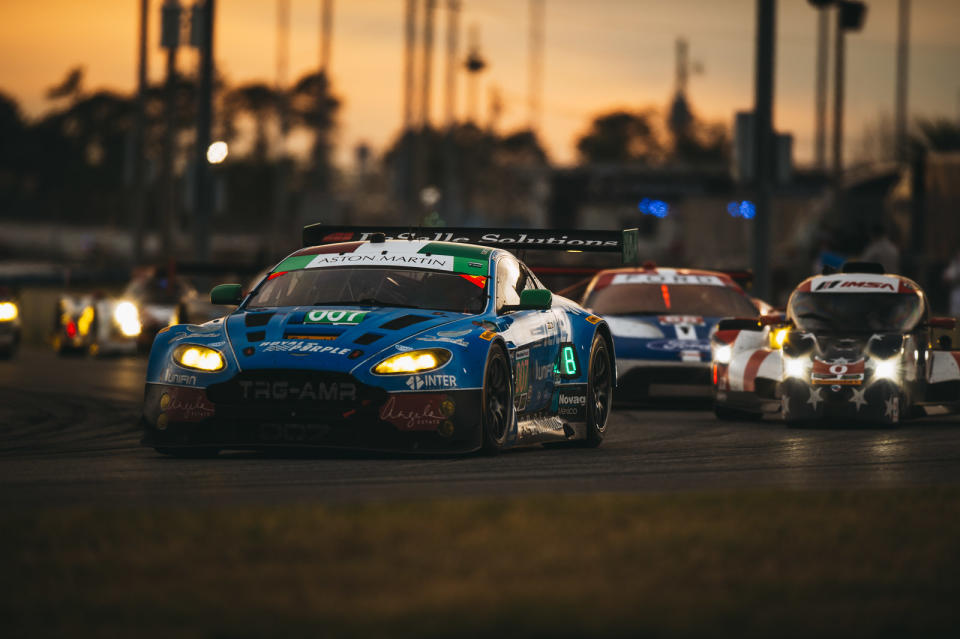Horsepower-Addled Observations From My First 24 Hours of Daytona
"It's impossible to take in everything going on at the 24 Hours of Daytona." That was the wisdom given to me by countless knowledgable folks when I told them I'd be attending the legendary endurance race for the very first time. They were right. But armed with a pocket notebook, a press pass, and a memorized map of every caffeine source at the Daytona International Speedway, I still endeavored to experience everything I could during my first visit to the Rolex 24. These are my observations, jotted down during coffee breaks, furtive naps, and any time something magical happened on the way to the checkered flag.

After a Thursday so rain-soaked we expected Noah's Ark to attempt a qualifying lap, the weather ahead of the green flag on Saturday was absolutely pristine. Campers, car clubs, and revelers of all sorts were pumped and ready when I arrived at the track around 11 a.m.
As the crews got in their last-minute adjustments and the cars lined up on the grid, there was plenty of noise-from the garages, from the crowds, from the announcements over the PA system. In hindsight, though, the hour leading up to the start of the race was probably the last chance to enjoy some relative quiet. Once they waved that green flag, we'd be in for a steady 24 hours of aural assault.

As a first-timer, the sound was astonishing. I'd attended practice earlier in the week, which gave a taste of the action, but nothing prepared me for the full effect of 54 vehicles representing four racing classes attacking the track.

It was loud. Not just NASCAR loud, or IndyCar loud, or Formula 1, or even NHRA loud. In each of those series, you have similar-sounding cars running somewhat close together for a relatively short period of time. At Daytona, four-cylinder turbocharged Mazda prototypes share the track with the twin-turbo V6 Ford GT and the naturally aspirated V8 Corvettes. It's a symphony of motors, ranging from thundering bass to wailing soprano, spreading from a tightly packed throng at the start of the race to a course-wide wall of noise as the space between competitors widened.
For tons more photos from our weekend at the 24 Hours of Daytona, check out our massive collection:
About two hours into the race, I put my foot on the bumper of my car, parked pretty much dead-center in the infield, to tie my shoe. I could feel the engine noises vibrating through the car and into the sole of my boot. That's how loud it was.

After awhile at Daytona, you start to memorize the sound of the various cars. The Corvette Daytona Prototypes (like Action Express Racing's No. 5, shown above) and the factory-backed Corvette C7.Rs both use the same naturally aspirated 5.5-liter pushrod V8; the open-cockpit Prototype Challenge racers all used Chevy V8 power as well. In a field of screaming prototypes and howling GT cars, the Chevy-powered machines sounded less like exotic racers and more like lost NASCAR Sprint Cup cars. They sounded like they were hard at work doing serious business, unconcerned with the playthings around them.

The twin-turbo V6 used in Ford's two factory-backed GTs (shown above) and Chip Ganassi's two Ford-powered Riley Daytona Prototypes had an equally distinctive aural signature. Call it a mid-range moan. In the heavy braking zone coming into Turn 1, the downshift-blipping Fords sounded like a car hitting the rumble strips at the end of a highway off-ramp; accelerating off of the Turn 3 horseshoe, their slightly tinny exhaust note and short gearing combined to make a sound not unlike a throaty four-stroke dirtbike.

Despite all the wild machinery of the Prototype class, the most exotic sounding cars in the field were the relatively production-based Porsche 911 GT3 RSRs in the GT Le Mans class. While the turbocharged competitors bellowed in the middle of the scale, the naturally aspirated Porsche Motorsports North America factory racers positively shrieked. Of all the cars out there, the Porsches sounded the most like what you expected from European race cars.

To us snowbound northerners, a weekend in Daytona in January sounds like a tropical vacation. Blessedly, the weather cooperated with this fantasy, providing the kind of sunny mid-60s weather that makes snowbelt dads whip out their cargo shorts. But even though I'm in Florida, it's still January-on Saturday, the sun sets at 6 o'clock on the dot, not to return for more than 13 hours. Make no mistake, friends: This is a nighttime race.
The sunset helped fix the reality of the next 20 hours in my mind. I'm used to the rhythms of a standard-length race, three to five hours and a checkered flag. As the sky took on tropical splashes and the cars kept rumbling by, I settled in for a long, loud night.

The race takes on a completely different character after dark. As the temperature drops, campfires dot the infield; golf carts putter around carrying revelers and racing professionals alike, their eerie cyclops-like central headlights piercing the night.
This year, the racing teams went all-out with the LED character lighting on their cars. Originally done to help distinguish between a team's two cars at a distance, the illuminated highlights on this year's contenders approached SEMA show car levels of outlandishness. Screaming across the Florida night, the fluorescent glowing streaks made the race feel otherworldly.

 Yahoo Autos
Yahoo Autos 